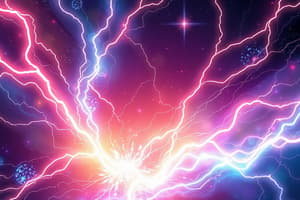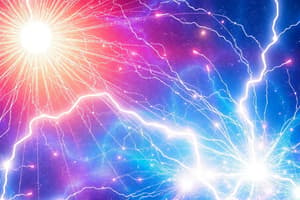Podcast
Questions and Answers
A rubber rod is rubbed with fur, causing the rod to become negatively charged. Which of the following statements best describes what has occurred?
A rubber rod is rubbed with fur, causing the rod to become negatively charged. Which of the following statements best describes what has occurred?
- The fur is now positively charged by induction.
- Protons have been transferred from the rod to the fur.
- The rod has gained positive charges.
- Electrons have been transferred from the fur to the rod. (correct)
Two identical metal spheres have charges of $+6q$ and $-2q$. They are brought into contact and then separated. What is the final charge on each sphere?
Two identical metal spheres have charges of $+6q$ and $-2q$. They are brought into contact and then separated. What is the final charge on each sphere?
- $-2q$ on each sphere
- $+8q$ on one sphere and $-4q$ on the other
- $+4q$ on each sphere
- $+2q$ on each sphere (correct)
A small charged object is placed in an electric field of 3000 N/C. The object experiences a force of 6.0 x $10^{-4}$ N. What is the magnitude of the charge on the object?
A small charged object is placed in an electric field of 3000 N/C. The object experiences a force of 6.0 x $10^{-4}$ N. What is the magnitude of the charge on the object?
- 1.8 x $10^{-9}$ C
- 5.0 x $10^{6}$ C
- 2.0 x $10^{-7}$ C (correct)
- 3.0 x $10^{-6}$ C
What is the current in a wire if 3.0 Coulombs of charge pass through it in 6.0 seconds?
What is the current in a wire if 3.0 Coulombs of charge pass through it in 6.0 seconds?
In the river analogy for electrical circuits, which of the following best corresponds to electrical resistance?
In the river analogy for electrical circuits, which of the following best corresponds to electrical resistance?
Flashcards
Charging by Friction
Charging by Friction
Transferring charge between objects by rubbing them together.
Charging by Conduction
Charging by Conduction
Charging a neutral object by touching it with a charged object.
Charging by Induction
Charging by Induction
Redistributing charge in an object without direct contact, using an external charge.
Polarization
Polarization
Signup and view all the flashcards
Electrical Current
Electrical Current
Signup and view all the flashcards
Study Notes
- The quiz focuses primarily on Chapter 16, specifically the 16-17 review guides.
- Chapter 17 material will also be included.
Charging Methods
- Understand and apply the principles of Friction, Conduction, Induction, and Polarization to various situations.
Conceptual Questions
- Expect short answer questions on conceptual topics from labs or WA.
Chapter 16 Problem Solving
- Convert between the number of electrons lost or gained and the corresponding charge in Coulombs.
- Solve Coulomb's law problems that have typical static charges in microcoulombs or charges given in terms of elementary charge (e).
- Solve for the Force, expressing the answer in Newtons.
- Solve simple Electric Field problems, and note that the units are in N/C.
Chapter 17 Problems
- Solve one mathematical problem related to electrical current and its units.
- 1 ampere is equal to 1 Coulomb per second (1 A = 1 C/s).
- More advanced Electric Field problems might be included as Extra Credit(EC).
Chapter 17 Content
- Define and apply Electrical Current, Potential Difference, and Electrical Resistance.
- Know the units for each of these quantities.
- Understand the River Analogy and how it connects Electrical Current, Potential Difference, and Electrical Resistance.
Studying That Suits You
Use AI to generate personalized quizzes and flashcards to suit your learning preferences.




